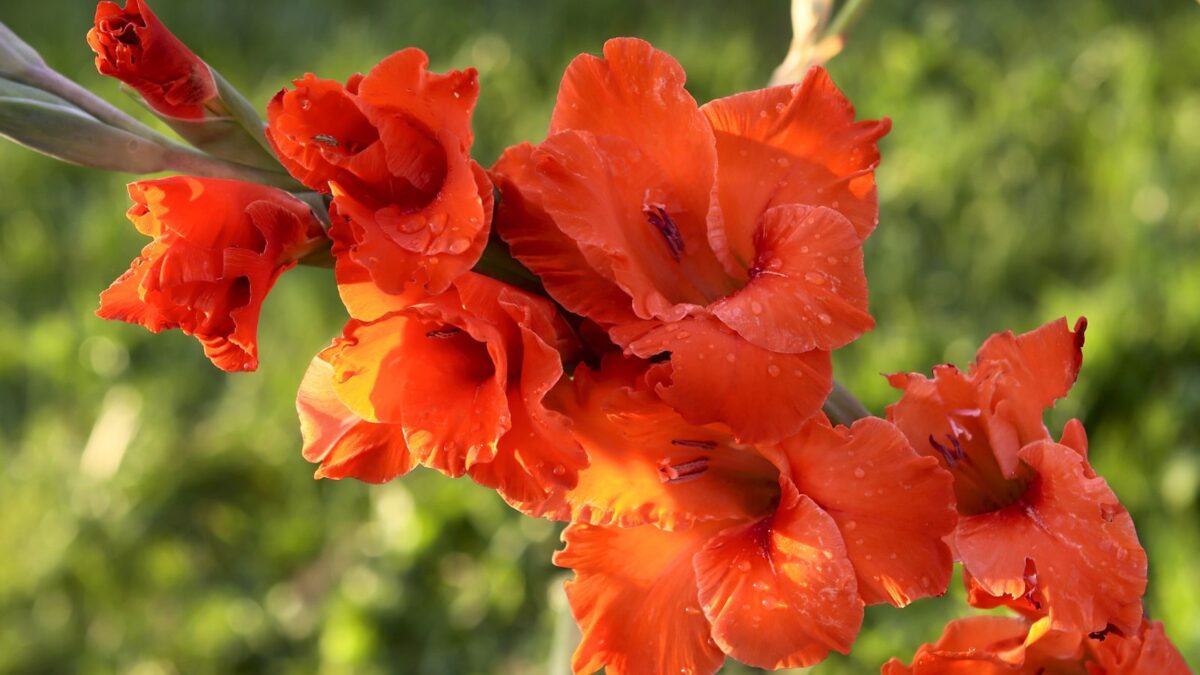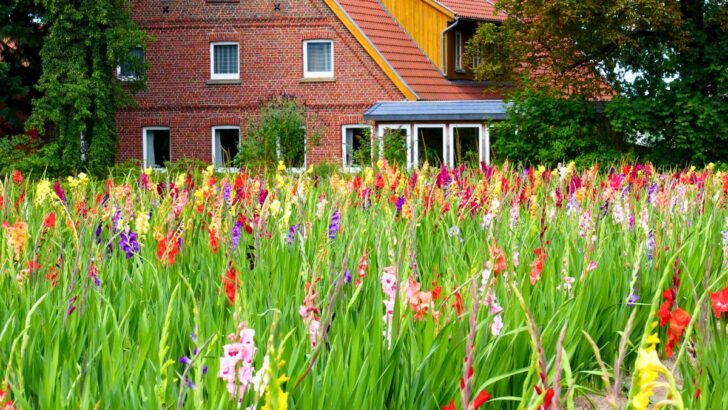The gladiolus (Gladiolus x hortulanus) has been cultivated and loved since early times, but today’s range of color, size, and forms has far outclassed its early beginnings. These flowers make stunning bouquets. Wouldn’t you love to know how to grow gladiolus?

Gladiolus varieties and hybrids
Gladiolus is a member of a huge family of colorful and richly flowering varieties and hybrids. Most of the over 200 species come from South Africa, although some of the smaller flowering varieties come from around the Mediterranean, especially the eastern area.
Here’s a beautiful Mediterranean-style garden.
Legends tell us of the important role that the Gladiolus played in ancient feasts and ceremonies, and wall paintings of this historic plant were found in the ruins of Pompeii.
How To Grow Gladiolus

The bulbs of the Gladiolus are called corms and are usually slightly flattened and covered with a mesh-like membrane.
The sword-like leaves have led to the plant’s Latin name since the word ‘Gladiolus’ means “little sword.”
The trumpet-shaped flowers are clear and intensely colored. Modern Gladioli produce stems up to 5 feet tall, each bearing 25 or more florets (12-14 opening at one time). Miniature varieties grow to 3 feet and produce spikes of 15-20 flowers.
Plant Gladiolus corms in the spring. You can purchase them at the garden center or by mail order. Smaller corms are cheaper than large ones, but they will produce smaller flower spikes.
The seasons of the Gladiolus
In November – Inspect the corms to see if they are shriveling from too much heat or developing rot from being kept too damp and cool.
May through June – Dust the corms with a fungicide, and plant the corms after all danger of frost has passed and the ground has warmed.
Choose a sunny location with rich, well-drained soil. Set each corm at 4-5 times the depth of its height and 4-6 inches apart.
July through August – Give plenty of water in this growth period and add a weak liquid fertilizer every second or third time it is watered. It may be necessary to support the plants with bamboo canes.
Cut spikes when the lowest flower begins to open.
September through October – Dig the corms when the foliage yellows and dries. Cut the tops off just above the corm.
Burn or discard the dried tops in trash containers, and dry the corms in a shady, well-ventilated place. Dust the corms with a fungicide and store them in a dark place at 40-50 F.
Gladiolus Pests and Diseases
- Small, black patches on the corms are dry rot – use fungicide!
- Gray, furry patches on corms are gray mold. If the attack is too bad, throw the corms away.
- Clear, dark, or lighter stripes on the leaves in the summer are a sign of a virus attack. Once again, out with them! (But not on the compost heap.)
- Pale patches on the leaves. This means thrips (the most serious problem in Midwest gardens). Fight them with a chemical insecticide. Many sprays at frequent intervals will be needed.
Gladiolus plants usually last about 3-5 years. Eventually, either the corms will expire or the flowers will be discolored. If you live in an area where winter comes early, you might have trouble growing gladiolus.
Beautiful Gladiolus Flower Pictures
Today, Gladiolus is available in a wide range of colors and heights. Here’s just a small sampling for your delight.

I love this orange gladiolus. It makes my front door a happy place.

What a pretty pink color!

Nature is such a good artist! Just look at their brightly colored red and yellow flowers!
Plant a few in your garden and enjoy the show!



Veronica
Saturday 28th of May 2022
My gladiolus are wilting over. Not the flowering stalks, but the stalks that have not flowered yet. They look really dry… but it rained all day yesterday….yesterday all of the plants were fine. Now today, all are wilting over.
How To Grow Peacock Orchids - A Quick And Complete Guide
Monday 21st of February 2022
[…] actually a member of the Iris family. Peacock orchids are not true orchids, but rather relatives of gladiolus. These plants reach 28-40 […]
Beautiful Flower Garden Ideas
Tuesday 23rd of February 2021
[…] How To Grow Gladiolus And Add Color To Your Garden […]
Ashley Bogan
Monday 2nd of March 2020
I'm in the upstate of South Carolina. My Asian lillies, dahlias, day lilies, irises,and daffodils all do fine overwintering left in the ground. Would gladiolus be OK too, or are these less cold hearty than what I've mentioned?
ILoveGardening
Tuesday 3rd of March 2020
Absolutely, they do just fine here in VA, and SC is warmer.
Jennifer
Friday 22nd of June 2018
Will they tolerate the Florida heat? I’m in Tampa region. Hot, wet summers, moderate dry winters
ILoveGardening
Friday 22nd of June 2018
Probably not. They are fine in parts of FL, but you are in the South and it's way too hot :(